When and how to plant currants in spring: terms and rules for planting seedlings in open ground
Currant is a rather unpretentious berry shrub, which just needs to be planted correctly and in the future perform simple maintenance in order to feast on tasty and healthy berries annually (and also brew tea from the leaves).
Next, you will find out when and how to plant currants in the spring so that they bear fruit well and abundantly, what you need to take into account, which place to plant to choose, how to fill the planting hole and many other nuances.
Important! White, red and black currants are planted the same way.
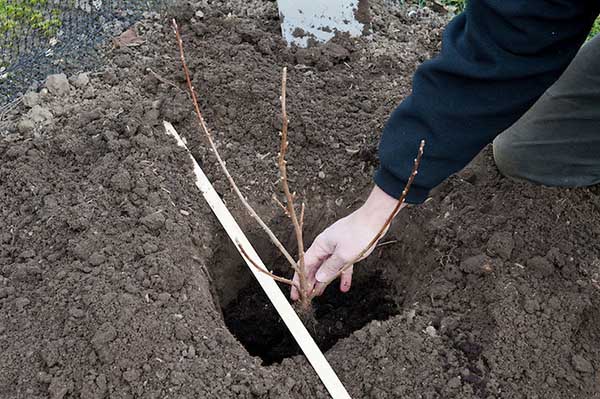
Content
When to plant currants in the spring, in what month: optimal timing
As for when to plant currant seedlings, it is recommended to do this immediately after the snow melts, while the ground is still wet (but already warmed up, not frozen). In this case, you need to have time before budding on the shoots of the shrub, planting before the currants begin to vegetate.
Note! If you bought a seedling in a container (with a closed root system - ZKS), then it can be planted later (already in a vegetative state - with leaves). The fact is that seedlings with ZKS can be planted all year round (even in summer).
Thus, the timing of the spring planting of currants will directly depend on the climate of your region and the weather conditions of this year.
When to plant in spring in different regions
Naturally, depending on climatic features, the approximate timing of spring planting of currants in different regions will differ:
- So, in the South of Russia, currants can be planted already in late March-early April.
- But the gardeners of the Middle Strip (Moscow region) will have to wait until the second half of April (at least).
- In Siberia and the Urals, start planting currants no earlier than May (at about the same time in the North-West - in the Leningrad region).
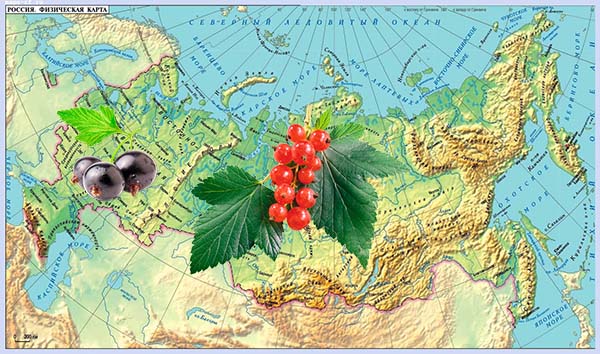
According to the lunar calendar for 2020
To choose the optimal date for spring planting of currant seedlings can help you Moon calendar.
So, favorable days for spring planting of currants in 2020, according to the lunar calendar, are:
- in March - 26-29;
- in April - 11-15, 24, 25;
- in May - 2-10.
Of course, it is not always possible to get to the dacha on favorable days, so the main thing is not to land on unfavorable dates - the days of the New Moon and Full Moon, as well as the period when the Moon is in Aquarius, because it is a barren and dry sign - in italics.
Unfavorable days, according to the lunar calendar for 2020, for planting currant seedlings in spring, the following dates are:
- in March - 9,19-21, 24;
- in April - 8,15-17, 23;
- in May - 7,13-14, 22;
- in June - 5,9-11, 21.
According to the Lunar Calendar, from the magazine "1000 Tips for Summer Residents".

When is it better to plant - in spring or autumn
Indeed, many novice gardeners are constantly thinking about when it is better for them to plant currants - in spring or autumn.
In fact, this is not so important - when it is more convenient for you, then plant.
Although many believe that it is berry bushes (gooseberry, raspberries) it is better to plant exactly in the fall (3-4 weeks before the onset of frost), because after planting in spring, the shrub spends energy on the growth of shoots and leaves, as well as on the development of the root system, in the fall, in currants, all forces are directed exclusively towards rooting.
By the way! The site has a separate material about the autumn planting of currants.
However, this does not mean that you cannot plant bushes. in early spring... The only difference is that you will need to pay a little more attention to your seedlings, because you will have to monitor them throughout the warm period, while in the fall they will simply go into winter.
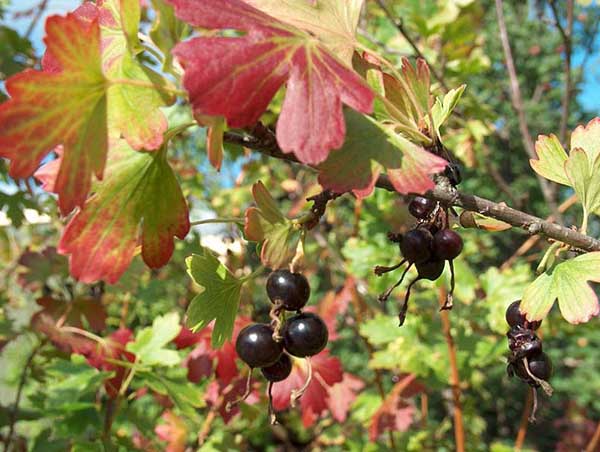
Correct planting of currants in the spring: step by step instructions
How to choose and prepare a seedling for planting
The main rule: the height of the aboveground part of the seedlings should be approximately equal to its underground part (roots), while the length of the roots should be at least 20-25 cm (and preferably they should be fibrous).
Advice! Better to buy a short sapling with a well-developed strong root systemthan tall with small roots. The fact is that you will have to cut off the second one after planting, otherwise it simply will not take root.
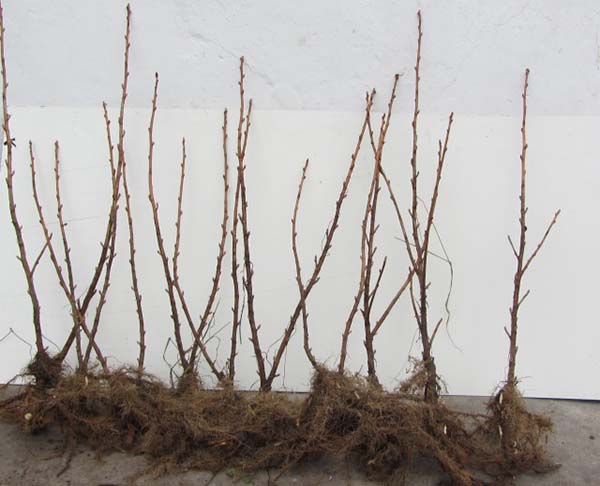
Note! As for age, it is worth giving preference to 1-year-old seedlings, in which the buds come from the very bottom (in two-year-olds, they are mostly at the top), and they also have more fibrous roots (in adults, the roots are larger and bare).
Naturally, the seedling should be healthy and free from any signs of disease or pest infestation (powdery mildew, glass, kidney mite etc.), as well as mechanical damage.
Advice! When buying a seedling in a container (with ZKS), you can also check its root system. Namely, how well the roots braided the earthy ball, and that the plant was actually originally planted and grown in a container. To do this, you need to slightly drag the seedling by its aboveground part, holding the container. If it sits firmly, then everything is fine. If it pulled out without resistance, it means that the plant was stuck in the pot a couple of weeks ago and the seller is a deceiver.
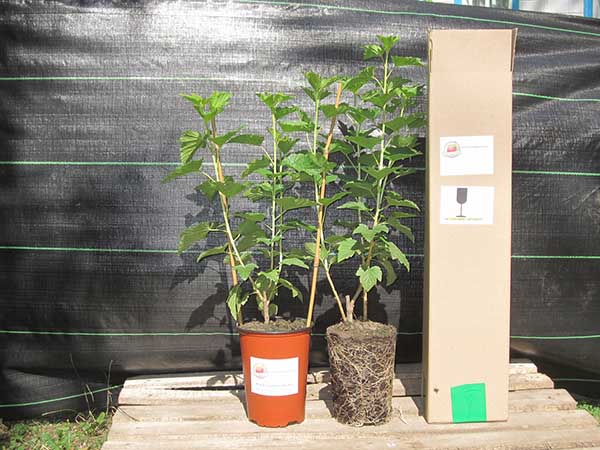
How to prepare a seedling for planting
If you purchased a seedling with an open root system, then you will need to somehow save it before planting. Alternatively, you can wrap the roots with a damp cloth and place in a bag.
And before planting in the ground, for better survival of a seedling, its rhizomes can be dipped in a clay mash or supported for a couple of minutes in any root formation stimulator (for example, in Heteroauxin or Kornevin).
Landing place
The most suitable place for planting currants is a well-lit area.
However, it is still desirable that the shrub is planted on the south side, in a place where it will be completely protected from northern (cold and dry) winds and drafts (for example, by some kind of structure or dense plantings).
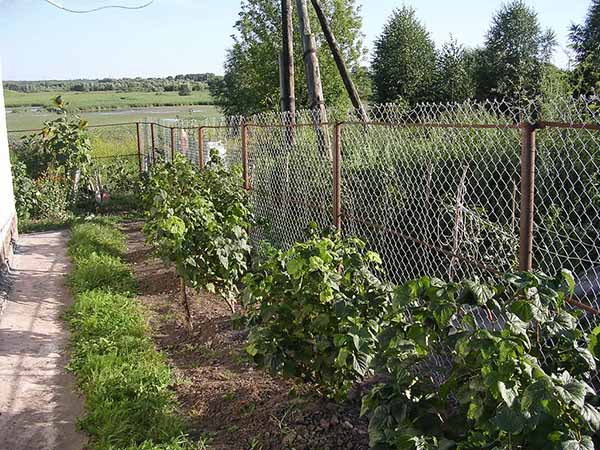
By the way! It is believed that the currants are quite tolerant of light shading (at noon), it even benefits it, because berries often suffer from sunburn.
However! A deaf shadow behind a shed or near a fence, a near-stem circle of a spreading fruit tree, even overgrown raspberry bushes - all these are completely unsuitable places for planting currants. There she will bear poor fruit and more often be affected by diseases.
Thus, shady, as well as waterlogged and swampy places in the lowlands, where melt water accumulates and stagnates in spring, are not suitable for planting currants. Bushes planted in such areas will hurt and, as a result, are likely to die.
If your groundwater is close (closer than 1.5 meters), then in this case you should plant currants on an artificial hill (a mound or an analogue of a high bed).
At what distance to plant - planting scheme
It is worth knowing that while growing, currant bushes fill a large enough space with themselves, so it makes no sense to plant them close: it will be corny for you to look after them and harvest them.
Therefore, it is optimal to place currant bushes at a distance of 1.5-2 meters apart.
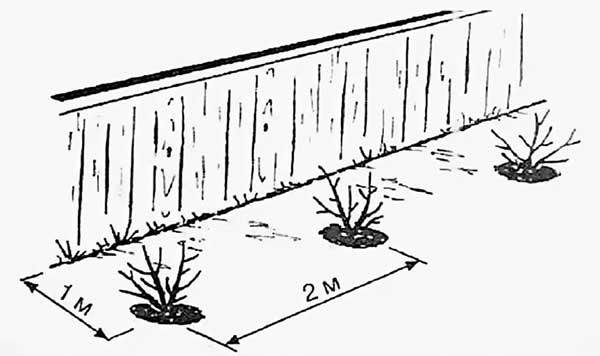
Important! In this case, you should also retreat from the fence at least 1 meter.
Culture Neighborhood Rules
As a rule, next to currants it is not recommended to plant gooseberriessince in cultures common diseases (powdery mildew) and pests (aphid), and in the case infestation of one plant, the second is likely to suffer too. However, if you do regular treatments for diseases and peststhen nothing like this will happen.
That's exactly what do not plant currants closeso it is with raspberries... The fact is that its tall shoots can simply shade your currant bushes, and without light, the berries will not sing and gain sweetness.
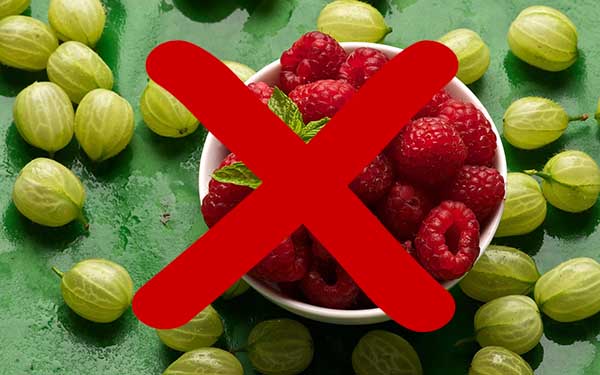
What soil is needed
Currants prefer to grow on light (loose) and fertile soils, the same loam or sandy loam soil. At the same time, the acidity of the soil can be either neutral (pH 6-7), or close to neutral (pH 5.5-6) and even slightly slightly acidic (pH 5.2-5.5).
Important! Currants, like many other plants (except for heathers), will not grow well if the soil is too acidic.
Accordingly, you need to first measure (define), and then change soil acidity.
You can lower the acidity (deoxidize) the soil by adding to it dolomite flour, lime, chalk or wood ash.
Of course, if fertilizers are applied in a timely manner, humus or compost is added, and regular watering is performed, currants will grow well on poorer sandy or clay soils.
However, if the soil is excessively clayey, then the water will stagnate, the root collar will rot and the seedling will simply disappear. On the contrary, if the soil is too sandy, the seedling may dry out from lack of moisture, which will evaporate very quickly after watering.
To what depth to plant (size of the planting pit)
The optimal size of the planting pit for currants is 50 to 50 centimeters (depth and width / diameter).
Remember! The larger the hole, the more fertile soil you can lay in it.
However, if you already have initially fertile land, then there is no need to dig such a deep hole: it will be enough to make a 30-40 cm hole.
Advice! If you are planting a seedling with a ZKS (in a container), then the hole should simply be 2 times larger than the earthen coma (pot).
When digging a planting hole, fold the fertile layer separately from the infertile one (clay / sand).
How and what to fill the planting hole
The planting pit for planting a currant seedling is filled with the following fertile substrate (organic and mineral fertilizers):
- the upper fertile layer of soil (which you have left after digging a hole);
Advice! If the soil is too clayey, then you can add sand, if, on the contrary, it is too sandy, then clay.
- compost or humus (4-8 kg, about half or one bucket);
- deoxidized high-moor peat (to further improve aeration);
- superphosphate (80-100 grams) or 200-300 grams of bone meal;
- potassium sulfate (60-80 gr) or 100-200 gr wood ash.
Or you can simply pour in about 80-100 grams of diammophoska (or, in extreme cases, nitroammofoska), of course, if you allow the use of mineral fertilizers.
At the same time, mineral fertilizers must be carefully to mix with earth (top layer) and humus, peat, and then pour a small cushion of fertile soil mixed with humus (no fertilizer).
Do not forget! Also, you should have fertile soil (garden soil + humus or compost + peat) for filling the seedling.
Direct landing
Phased planting of a currant seedling in the spring:
- Fill the planting hole with soil mixture (with fertilizer) to about half.
- Further, if desired (many water only after planting, others - both before and after - as you like), you can slightly spill nutrient soil with water.
- Now you need to make a small cone-shaped mound in the center of the planting hole (from garden soil and humus, peat, without mineral fertilizers).
If you are planting a seedling in a container (with ZKS), then no mounds need to be poured, but simply get out and put the seedling in a prepared planting pit (on a flat surface) without breaking the earthen coma.
- Place the seedling at an angle of 45 degrees in the center of the mound and spread the roots down to the sides (The roots should never bend and stick up!).
Note! Unlike gooseberries, currants are recommended to be planted obliquely, at an angle of 45 degrees. In this case, the root should look to the south, and the shoots to the north.
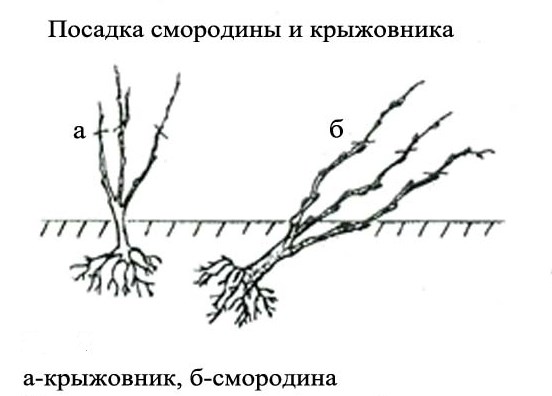
Worth knowing! The root collar is the place where the first root originates from the trunk.
Note! As a rule, when planting, it is recommended to bury the root collar 5-10 centimeters into the soil (so that the lower buds are underground) for good tillering (3-5 cm on heavy and clay soil, 7-10 cm on light sandy soil). This will enable the currants to develop additional shoots directly from the ground and thereby significantly increase the width of the bush.
However, given that the ground is likely to settle, it is better not to deeply deepen initially.
- Cover the seedling with fertile soil (garden soil mixed with humus or peat), while slightly lifting and shaking the seedling so that the earth wakes up between the roots and fills all the voids.
- Slightly compact the soil so that the seedling “anchors” in a new place.
- Next, you need to make the sides along the diameter (perimeter) of the near-trunk circle 5-10 cm high (from the infertile soil left after digging the hole).
- And pour it abundantly, pouring out about a bucket of water (Pour out gradually - wait for it to be absorbed, and add more).
Video: how to plant currants in spring
Currant care after planting in spring
Immediately after planting the currants, you need cut off the aerial part of the bush, leaving no more than 2-4 buds on each shoot (if you have two, then 2 buds, if one, then you can 3-4).
Of course, if the seedling was not cut by the seller, because, as a rule, it is sold or sent in this form.
Don't be afraid to shorten the aerial part of the plant! This is a very useful agronomic technique for better rooting of all seedlings (both shrubs and trees).
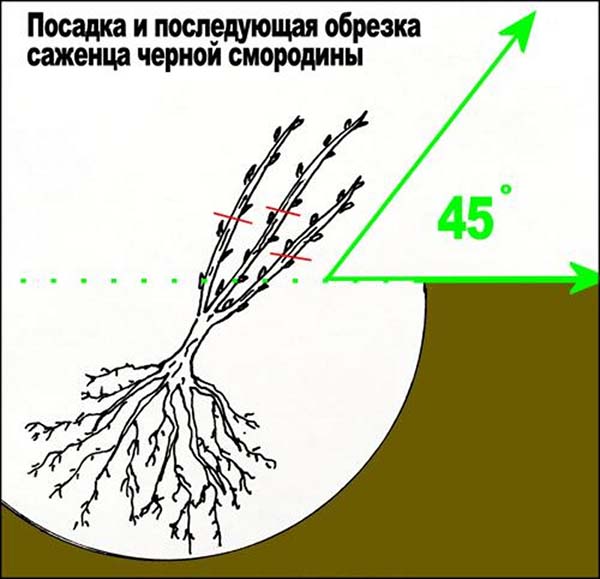
- Why crop after planting?
The fact is that the main goal of the plant is, first of all, to build up the root system in order to take root in a new place, and then the aboveground part. For this, it is shortened and equalized with the underground.
Further it is highly desirable mulch near-trunk circle of currants with mown grass, hay, straw, rotted sawdust, compost and other mulch.
Why should currants be mulched?
- After abundant watering, a dry crust often forms. Thanks to mulch, the soil will always be loose, and moisture will last longer.
- Weeds will not grow under the mulch.
- Mulch is an excellent organic food supplement.
Note! The most important post-plant currant care activity will be regular and timely. watering. It will have to be watered almost weekly (especially during drought periods - in summer in the July heat).
And in the fall you need to be right prepare the bushes for winter.
About, how to care for currants in autumn to prepare for winter, described in detail in this article.
In general, the list basic activities for the care of currants includes the following:
By the way! About, what to do with currants in spring (how to care), detailed here, and in the fall, during preparation for winter, — here.
- top dressing (if you added the recommended amount of fertilizer to the planting pit, then next time you need to feed it only after 2-3 years);
The site has detailed articles about spring and autumn feeding of currants.
- trimming (spring and autumn (after harvest);
- treatment for diseases and pests;
About, when and how to process currants in spring, told here (in particular boiling water), in the fall - in this material.
- If aphids attack your currants, then it will be useful for you specifically this article, which tells about all possible ways to combat aphids on currant bushes.
- The leaves turned red - look for the reason in this material.
- transfer to another place.
Advice! The site also has a detailed article on how how to transplant currants correctly in spring, summer and autumn.
Thus, even a novice gardener can plant currants in the spring. During the warm period, the shrub will have time to take root well and completely take root in a new place, which means that in a year it will delight you with abundant fruiting.
Video: when and how to plant black currants correctly

